-

新人教版高中英语选修2Unit 1 Science and Scientists-Learning about Language教学设计
Step 7: complete the discourse according to the grammar rules.Cholera used to be one of the most 1.__________ (fear) diseases in the world. In the early 19th century, _2_________ an outbreak of cholera hit Europe, millions of people died. But neither its cause, 3__________ its cure was understood. A British doctor, John Snow, wanted to solve the problem and he knew that cholera would not be controlled _4_________ its cause was found. In general, there were two contradictory theories 5 __________ explained how cholera spread. The first suggested that bad air caused the disease. The second was that cholera was caused by an _6_________(infect) from germs in food or water. John Snow thought that the second theory was correct but he needed proof. So when another outbreak of cholera hit London in 1854, he began to investigate. Later, with all the evidence he _7_________ (gather), John Snow was able to announce that the pump water carried cholera germs. Therefore, he had the handle of the pump _8_________ (remove) so that it couldn't be used. Through his intervention,the disease was stopped in its tracks. What is more, John Snow found that some companies sold water from the River Thames that __9__________________ (pollute) by raw waste. The people who drank this water were much more likely _10_________ (get) cholera than those who drank pure or boiled water. Through John Snow's efforts, the _11_________ (threaten) of cholera around the world saw a substantial increase. Keys: 1.feared 2.when 3. nor 4.unless 5.that/which 6.infection 7.had gathered 8.removed 9.was polluted 10.to get 11. threat

新人教版高中英语选修2Unit 1 Science and Scientists-Reading and thinking教学设计
Step 5: After learning the text, discuss with your peers about the following questions:1.John Snow believed Idea 2 was right. How did he finally prove it?2. Do you think John Snow would have solved this problem without the map?3. Cholera is a 19th century disease. What disease do you think is similar to cholera today?SARS and Covid-19 because they are both deadly and fatally infectious, have an unknown cause and need serious public health care to solve them urgently.keys:1. John Snow finally proved his idea because he found an outbreak that was clearly related to cholera, collected information and was able to tie cases outside the area to the polluted water.2. No. The map helped John Snow organize his ideas. He was able to identify those households that had had many deaths and check their water-drinking habits. He identified those houses that had had no deaths and surveyed their drinking habits. The evidence clearly pointed to the polluted water being the cause.3. SARS and Covid-19 because they are both deadly and fatally infectious, have an unknown cause and need serious public health care to solve them urgently.Step 6: Consolidate what you have learned by filling in the blanks:John Snow was a well-known _1___ in London in the _2__ century. He wanted to find the _3_____ of cholera in order to help people ___4_____ it. In 1854 when a cholera __5__ London, he began to gather information. He ___6__ on a map ___7___ all the dead people had lived and he found that many people who had ___8____ (drink) the dirty water from the __9____ died. So he decided that the polluted water ___10____ cholera. He suggested that the ___11__ of all water supplies should be _12______ and new methods of dealing with ____13___ water be found. Finally, “King Cholera” was __14_____.Keys: 1. doctor 2. 19th 3.cause 4.infected with 5.hit 6.marked 7.where 8.drunk 9.pump 10.carried 11.source 12.examined 13.polluted 14.defeatedHomework: Retell the text after class and preview its language points

新人教版高中英语选修2Unit 1 Science and Scientists-Using langauge教学设计
This happens because the dish soap molecules have a strong negative charge, and the milk molecules have a strong positive charge. Like magnets, these molecules are attracted to each other, and so they appear to move around on the plate, taking the food coloring with them, making it look like the colors are quickly moving to escape from the soap.Listening text:? Judy: Oh, I'm so sorry that you were ill and couldn't come with us on our field trip. How are you feeling now? Better?? Bill: Much better, thanks. But how was it?? Judy: Wonderful! I especially liked an area of the museum called Light Games.it was really cool. They had a hall of mirrors where I could see myself reflected thousands of times!? Bill: A hall of mirrors can be a lot of fun. What else did they have?? Judy: Well, they had an experiment where we looked at a blue screen for a while, and then suddenly we could see tiny bright lights moving around on it. You'll never guess what those bright lights were!? Bill: Come on, tell me!? Judy: They were our own blood cells. For some reason, our eyes play tricks on us when we look at a blue screen, and we can see our own blood cells moving around like little lights! But there was another thing I liked better. I stood in front of a white light, and it cast different shadows of me in every color of the rainbow!? Bill: Oh, I wish I had been there. Tell me more!? Judy: Well, they had another area for sound. They had a giant piano keyboard that you could use your feet to play. But then, instead of playing the sounds of a piano, it played the voices of classical singers! Then they had a giant dish, and when you spoke into it, it reflected the sound back and made it louder. You could use it to speak in a whisper to someone 17 meters away.? Bill: It all sounds so cool. I wish I could have gone with you? Judy: I know, but we can go together this weekend. I'd love to go there again!? Bill: That sounds like a great idea!

新人教版高中英语选修2Unit 2 Bridging Cultures-Discovering useful structures教学设计
The grammar of this unit is designed to review noun clauses. Sentences that use nouns in a sentence are called noun clauses. Nominal clauses can act as subject, object, predicate, appositive and other components in compound sentences. According to the above-mentioned different grammatical functions, nominal clauses are divided into subject clause, object clause, predicate clause and appositive clause. In this unit, we will review the three kinds of nominal clauses. Appositive clauses are not required to be mastered in the optional compulsory stage, so they are not involved.1. Guide the students to judge the compound sentences and determine the composition of the clauses in the sentence.2. Instruct students to try to learn grammar by generalizing grammar rules, controlling written practice, and semi-open oral output.3. Inspire the students to systematize the function and usage of noun clause1.Instruct students to try to learn grammar by generalizing grammar rules, controlling written practice, and semi-open oral output.2.Inspire the students to systematize the function and usage of noun clauseStep1: The teacher ask studetns to find out more nominal clauses from the reading passage and udnerline the nominal clauses.

新人教版高中英语选修2Unit 3 Food and Culture-Discovering useful structures教学设计
The newspaper reported more than 100 people had been killed in the thunderstorm.报纸报道说有一百多人在暴风雨中丧生。(2)before、when、by the time、until、after、once等引导的时间状语从句的谓语是一般过去时,以及by、before后面接过去的时间时,主句动作发生在从句的动作或过去的时间之前且表示被动时,要用过去完成时的被动语态。By the time my brother was 10, he had been sent to Italy.我弟弟10岁前就已经被送到意大利了。Tons of rice had been produced by the end of last month. 到上月底已生产了好几吨大米。(3) It was the first/second/last ... time that ...句中that引导的定语从句中,主语与谓语构成被动关系时,要用过去完成时的被动语态。It was the first time that I had seen the night fact to face in one and a half years. 这是我一年半以来第一次亲眼目睹夜晚的景色。(4)在虚拟语气中,条件句表示与过去事实相反,且主语与谓语构成被动关系时,要用过去完成时的被动语态。If I had been instructed by him earlier, I would have finished the task.如果我早一点得到他的指示,我早就完成这项任务了。If I had hurried, I wouldn't have missed the train.如果我快点的话,我就不会误了火车。If you had been at the party, you would have met him. 如果你去了晚会,你就会见到他的。

新人教版高中英语选修2Unit 3 Food and Culture-Reading and thinking教学设计
The discourse explores the link between food and culture from a foreign’s perspective and it records some authentic Chinese food and illustrates the cultural meaning, gerography features and historic tradition that the food reflects. It is aimed to lead students to understand and think about the connection between food and culture. While teaching, the teacher should instruct students to find out the writing order and the writer’s experieces and feelings towards Chinese food and culture.1.Guide the students to read the text, sort out the information and dig out the topic.2.Understand the cultural connotation, regional characteristics and historical tradition of Chinese cuisine3.Understand and explore the relationship between food and people's personality4.Guide the students to use the cohesive words in the text5.Lead students to accurately grasp the real meaning of the information and improve the overall understanding ability by understanding the implied meaning behind the text.1. Enable the Ss to understand the structure and the writing style of the passage well.2. Lead the Ss to understand and think further about the connection between food and geography and local character traits.Step1: Prediction before reading. Before you read, look at the title, and the picture. What do you think this article is about?keys:It is about various culture and cuisine about a place or some countries.

新人教版高中英语选修2Unit 5 First Aid-Discovering useful structures教学设计
You have no excuse for not going.你没有理由不去。He was punished for not having finished his homework.他因未完成作业而受到惩罚。2.动词ing形式复合结构由物主代词或人称代词宾格、名词所有格或普通格加动词ing,即“sb./sb.'s+doing”构成。动词ing形式的复合结构实际上是给动词ing形式加了一个逻辑主语。动词ing形式的复合结构有四种形式:①形容词性物主代词+动词ing②名词所有格+动词ing③代词宾格+动词ing④名词+动词ingHer coming to help encouraged all of us.她来帮忙鼓舞了我们所有人。The baby was made awake by the door suddenly shutting.这个婴儿被突然的关门声吵醒了。Can you imagine him/Jack cooking at home?你能想象他/杰克在家做饭的样子吗?无生命名词无论是作主语还是作宾语都不能用第②种形式。Tom's winning first prize last year impressed me a lot.汤姆去年得了一等奖使我印象深刻。Do you mind my/me/Jack's/Jack leaving now?你介意我/杰克现在离开吗?Excuse me for my not coming on time.很抱歉我没能按时来。His father's being ill made him worried.他父亲病了,他很担心。We are looking forward to the singer's/the singer to give us a concert.我们盼望着这位歌手来给我们举办一场演唱会。
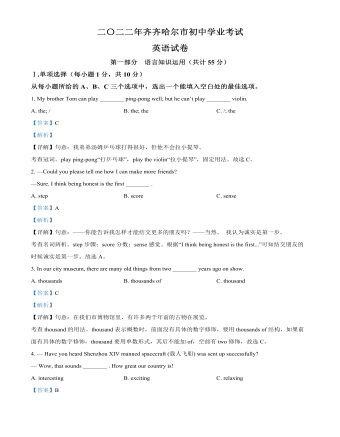
2022年黑龙江省齐齐哈尔市中考英语真题(解析版)
B: For 3 days. I expect togo there again.A: Lucky you. I had to stayat home. But I’m planning to travel to Mount Changbai.B: Oh, that’s a good place.I went there three years ago.
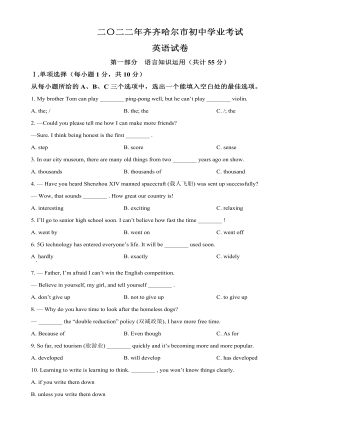
2022年黑龙江省齐齐哈尔市中考英语真题(原卷版)
(A: Sun Lan B: Li Yue C: Waiter)A: Hi! This is Sun Lan. MayI speak to Li Yue?B: Hi, Sun Lan! ________41________.Are you in Qiqihar now?A: Yes, I came back last night.

2022年湖北省黄冈市、孝感市、咸宁市中考英语真题(解析版)
When he was 12, his parents died. He was aloneand didn’t ____11____others. No one showed kindness to him. People always laughed ____12____ him. His only friend was adog named Bobby. He ____13____his dog enough to eat and drink, but he was a little rude(粗鲁的)to it sometimes.
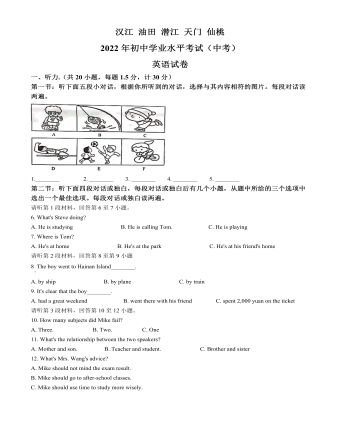
2022年湖北省江汉油田、潜江、天门、仙桃中考英语真题(解析版)
Penny’s family was very poor. Her father was asailor (水手).He earned very little money and was ____16____ away from home. Her mothercould not work ____17____she was often sick. One day.
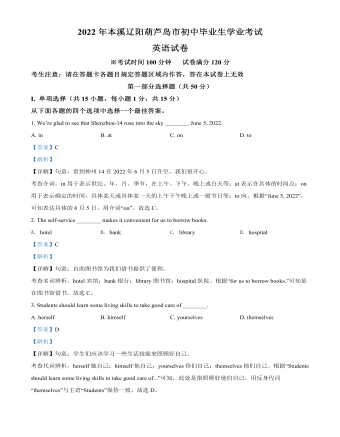
2022年辽宁省本溪市、辽阳市、葫芦岛市中考英语真题(解析版)
A bird went to look for happiness. On ___21___ way, she saw a flower, the flower was short ofwater, but his face was full of ___22___ .
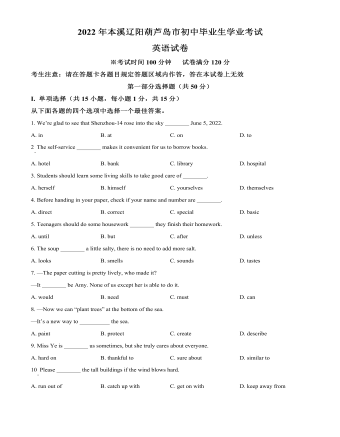
2022年辽宁省本溪市、辽阳市、葫芦岛市中考英语真题(原卷版)
When I was young, I dreamed of being anastronaut(宇航员)andflying into the space. Nowadays, my dream has come true. Traveling to the moonhas got popular. People between the ages of 18 to 60 are able to travel to themoon.
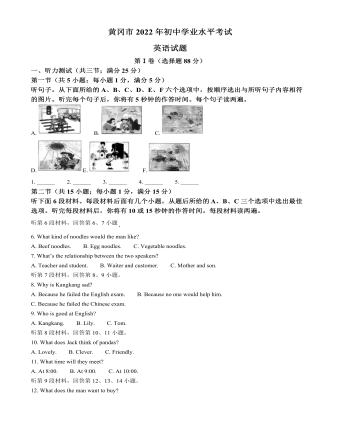
2022年湖北省黄冈市、孝感市、咸宁市中考英语真题(原卷版)
When he was 12, his parents died. He was aloneand didn’t ____11____ others. No one showed kindness to him. Peoplealways laughed ____12____ him. His only friend was a dog named Bobby. He____13____ his dog enough to eat and drink, but he was a little rude(粗鲁的)to it sometimes.
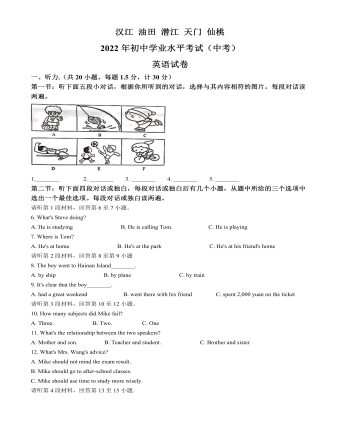
2022年湖北省江汉油田、潜江、天门、仙桃中考英语真题(原卷版)
Penny’sfamily was very poor. Her father was a sailor (水手). He earned very littlemoney and was ____16____ away from home. Her mother could not work ____17____she was often sick. One day. Penny’s mother said to Penny, “Our lamp (灯) isbroken. Go to the market on your way home from school and buy another one. Here’ssixty dollars. ____18____ to get a bargain (还价), dear.”
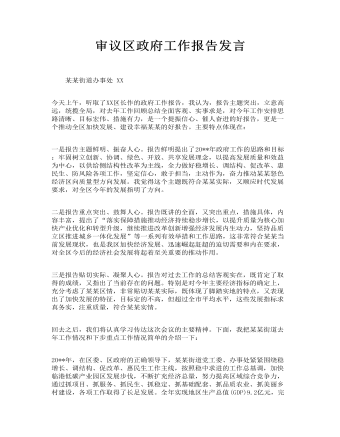
在青年干部座谈会发言
年轻干部要激情奋斗,唯有激情才能成长。激情是工作的灵魂。学习和工作中没有激情就好比身体失去了灵魂,什么事情也不可能真正做好。一年多的信访工作使我的感触颇多,最深的体会是:信访工作很苦,但苦中有乐;信访工作很难,唯艰难处长才能;信访工作很琐碎,唯琐碎才能做细。很庆幸的是,面对这样的信访工作,我依然热爱它,对它充满激情,依然精益求精地去办好每一件信访事项,一步一个脚印地走出为民解难的青春足迹。
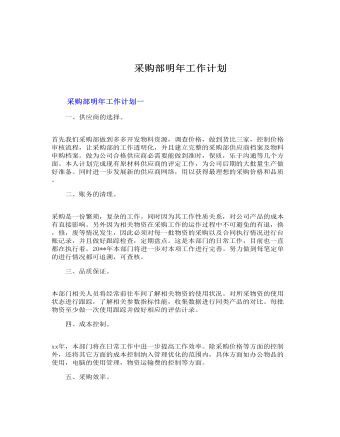
采购部明年工作计划
二、账务的清理。 采购是一份繁琐,复杂的工作。同时因为其工作性质关系,对公司产品的成本有直接影响。另外因为相关物资在采购工作的运作过程中不可避免的有退,换,修,废等情况发生,因此必须对每一批物资的采购以及合同执行情况进行台账记录,并且做好跟踪检查,定期盘点。这是本部门的日常工作,目前也一直都在执行着,20**年本部门将进一步对本项工作进行完善。努力做到每笔定单的进行情况都可追溯,可查核。
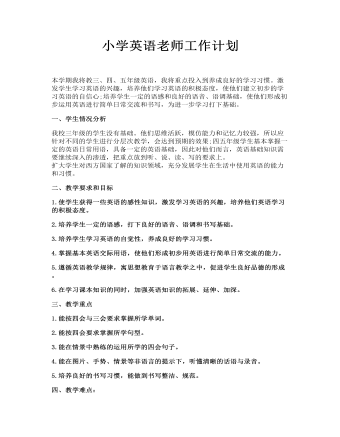
小学英语老师工作计划
二、教学要求和目标1.使学生获得一些英语的感性知识,激发学习英语的兴趣,培养他们英语学习的积极态度。2.培养学生一定的语感,打下良好的语音、语调和书写基础。3.培养学生学习英语的自觉性,养成良好的学习习惯。4.掌握基本英语交际用语,使他们形成初步用英语进行简单日常交流的能力。5.遵循英语教学规律,寓思想教育于语言教学之中,促进学生良好品德的形成。6.在学习课本知识的同时,加强英语知识的拓展、延伸、加深。
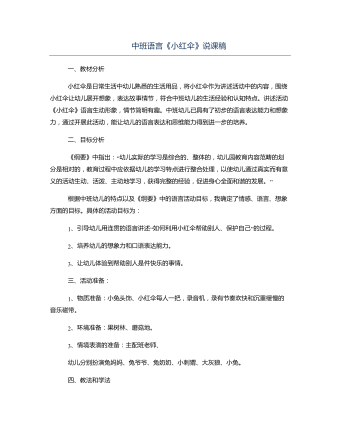
中班语言《小红伞》说课稿
在区角投放相关头饰让孩子继续表演、讲述故事内容,也可以将故事内容画出来,装订成小图书,让孩子讲述,进一步培养幼儿对讲述活动的兴趣。通过角色的扮演、语言的表述将幼儿带入故事情境中,一下子拉近了师生之间的情感距离,自然、亲切,再以过渡性的提问引出小红伞直接揭示课题,也为下一个环节作一个良好的铺垫。情境体验的环节中教者以音乐贯穿于情境一、情境二、情境三中,一是发挥音乐的教育功能,二是让幼儿体验到帮助别人、解决问题的喜悦心情。通过看看、想想、说说,孩子用多种感官参与活动,教者则发挥了引导者的作用。孩子的想法是多种多样的,教师都给予积极的评价。如果有孩子能提到讲述中的内容,就请他表演情境;反之,情境二的预设,也为下一个讲述内容作准备。心理学研究表明:视听结合,感知效果最佳。情境二所提供的视觉刺激和听觉刺激作用于幼儿的眼、耳,颇有新意,能牢牢抓住孩子兴趣,促进其思维的发展,提高了对讲述内容的记忆效果。
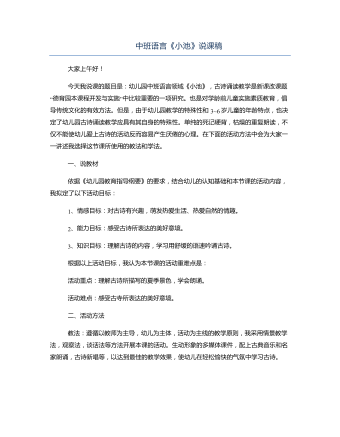
中班语言《小池》说课稿
今天我说课的题目是:幼儿园中班语言领域《小池》,古诗诵读教学是新课改课题“德育园本课程开发与实施”中比较重要的一项研究。也是对学龄前儿童实施素质教育,倡导传统文化的有效方法。但是,由于幼儿园教学的特殊性和3~6岁儿童的年龄特点,也决定了幼儿园古诗诵读教学应具有其自身的特殊性。单纯的死记硬背,枯燥的重复朗读,不仅不能使幼儿爱上古诗的活动反而容易产生厌倦的心理。在下面的活动方法中会为大家一一讲述我选择这节课所使用的教法和学法。

